People
Faculty
Sung-Gheel (Gil) Jang, Director Geospatial Center
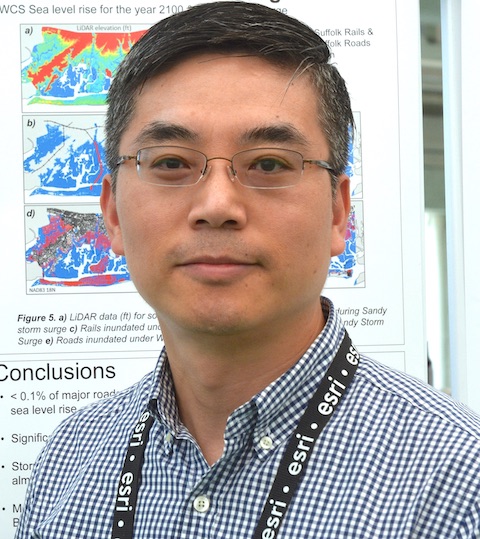
Sung-Gheel Jang is the director of Geospatial Center, and the faculty director of the Advanced Graduate Certificate of Geospatial Science and Minor in Geospatial Science (GSS). As a certified GIS Professional (GISP), Dr. Jang teaches both fundamental and applied topics in geospatial sciences/geographic information systems (GIS) including digital cartography, geospatial narratives, GIS design and application I & II, GIS database and design, GIS project management, and geospatial science for the coastal zone. All his courses offer extensive hands-on exercises, and deliver working knowledge and geospatial problem solving skills that students can apply in their future work.
His research interests encompass sharing geospatial information, urban sustainability and public health, and geospatial and human dimension on sustainable development. During summer 2014, Dr. Jang collaborated with an interdisciplinary research team of SoMAS on looking into future climate risks in Long Island funded by New York State Resilience Institute for Storms and Emergencies (NYS RISE), and derived future coastal flood risk maps using GIS. Recently he is working on developing an online geospatial information portal for teaching and research. As part of this effort, Dr. Jang is currently working with faculty members in the Department of History to implement a FAHSS funded project, Mapping Long Island. Dr. Jang is also participating in a multi-year research project, Cultural Social Map of Latino Long Island (led by Dr. Adrian Melgosa), which will document geospatial narratives of the Latino community in Long Island.
Before joining Stony Book, Dr. Jang taught at the Cleveland State University and served as program coordinator of a graduate certificate program in urban geographic information systems. He received his Ph.D. in Regional Planning from the University of Illinois at Urbana-Champaign, and both an MA in City Planning and a BS in Landscape Architecture from Seoul National University in South Korea.
Geospatial Center Website: https://stonybrook.edu/commcms/gss
Affiliate Faculty
Haluk Resit Akcakaya, Professor

Haluk Akcakaya is a Professor in the Department of Ecology and Evolution, his Ph.D. is from Stony Brook University. Dr. Akcakaya’s research focuses on developing and applying quantitative methods to address questions in conservation biology and environmental risk assessment. Research topics include: Climate change impacts on biodiversity, Status and trends of biodiversity, Species conservation, and Population dynamics.
Henry J. Bokuniewicz, Distinguished Service Professor

Henry J. Bokuniewicz is a Professor in the School of Marine and Atmospheric Sciences,
he received his Ph.D. from Yale University.
Dr. Bokuniewicz’s research is concerned primarily with the behavior of coastal sedimentary
systems and coastal groundwater hydrology. His students are working with the dynamics
of coastal processes, exploring, now, the role of infragravity waves and edge waves
in modulating coastal conditions especially the occurrence of rip currents. We are
involved with monitoring programs for ocean beaches to investigate shoreline changes,
beach dynamics and responses to storms. Other research is being done on wakes of large
ships moving across shallow harbors. Field work also is undertaken to quantify the
seepage of groundwater across the sea floor especially around oceanic islands as well
as to investigate the global impact of coastal groundwater seepage.
Robert M. Cerrato, Professor
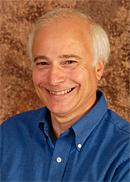
Robert Cerrato is a Professor in the School of marine and Atmospheric Sciences, he received his Ph.D. in Geology from Yale University. Dr Cerrato’s research has tried to identify factors that contributed to the decline, and more recently it has focused on the loss of function created by the decline and its consequences on populations of large suspension feeding bivalves such as the hard clam Mercenaria mercenaria have declined in the shallow, enclosed bays that are common features on Long Island. In addition, recently developed high-resolution acoustic methods such as side-scan and multibeam sonar provide a whole new class of environmental variables that can be related to benthic community structure.
Kamazima M. M. Lwiza, Associate Professor
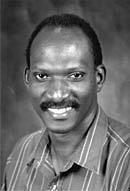
Kamazima Lwiza is an Associate Professor in the School of marine and Atmospheric Sciences, he received his Ph.D. in Marine Phyics from University of Wales. His research interests are the structure and dynamics of the shelf-seas, remote sensing oceanography and biological-physical interactions, which affect larval transport. He has designed field experiments to observe these processes by incorporating modern technology, with a particular emphasis on the acoustic Doppler current profiler (ADCP), GPS-tracked Lagrangian drifters, ocean gliders and satellites.
Dr. Lwiza is currently working on three projects. In the first one we are using IKONOS satellite data (1-m resolution) to study vegetation changes in mosquito habitat in Suffolk County in New York. The second project involves analyzing all water column data in Long Island Sound collected on monthly basis by Connecticut DEP from 1991 to present. We have so far been able to demonstrate that horizontal heat exchange with the adjacent coastal ocean is more dominant (>80%) than local surface heat exchange in controlling the interannual variability of temperature.
The third one we want to examine characteristics of internal waves in estuaries (our case study will be conducted in the Hudson River) produced by the small-amplitude topography regimes (h << U/N) where h is the topography amplitude, U the tidal velocity and N the buoyancy frequency.
Jaymie R. Meliker, Professor
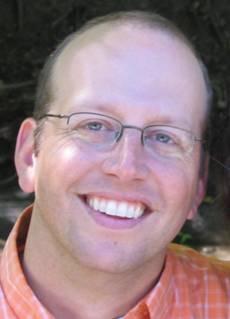
Jaymie Meliker is a Professor of Preventive Medicine in the Graduate Program in Public Health, he received his masters and Ph.D. from the University of Michigan School of Public Health. Dr. Meliker’s research contributes to the fields of exposure science, health geography, and environmental epidemiology. His scholarship falls into two lines of inquiry: (1) identifying environmental factors that play important roles in disease morbidity, and (2) developing space-time methods that improve our ability to investigate exposure-disease relationships.
Highlights of his work include pioneering development of space-time information systems for lifetime exposure reconstruction, and epidemiology of low-level exposure to arsenic in drinking water. He has published on drinking water contaminants, air pollutants, arsenic, cadmium, asthma, osteoporosis, stroke, and different types of cancers, and enjoys tackling environmental epidemiologic and spatio-temporal methodological problems to advance population health.
Glenn Richard, Education Coordinator for the Mineral Physics Institute

Glenn Richard has Maters of Science degree from Stony Brook University in Mineralogy and Sedimentology and a Masters of Arts from Brooklyn College in Computer Information Science. His research interests include Earth science education, geospatial technology, coastal processes and the natural history of the Pine Barrens ecosystem.
A. Deanne Rogers, Associate Professor
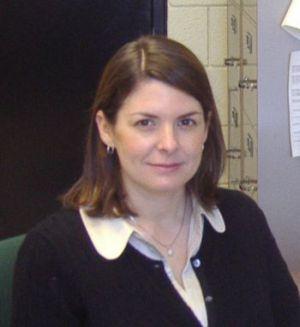
Deanne Rogers is an Associate Professor in the Department of Geosciences, she earned her Masters and PhD at Arizona State University and was a Postdoctoral Scholar at California Institute of Technology.
Dr. Rogers research involves the use of remote sensing techniques and laboratory spectroscopy to investigate planetary surface processes. Through site-specific, integrated spectral and geologic mapping, she is working to develop a stratigraphic, compositional and geologic framework for interpreting the style and duration of environmental conditions in which these various minerals formed. Other research includes infrared spectral characterization of sedimentary rocks and their constituent phases the objectives of this research are to 1) characterize the mid-infrared spectral properties of chemically precipitated phases and matrix materials in sedimentary rocks as a function of composition and particle/crystal size, and 2) understand the mid-infrared spectral mixing behavior of sedimentary rocks and their constituents.
Shawn Serbin, Assistant Ecologist
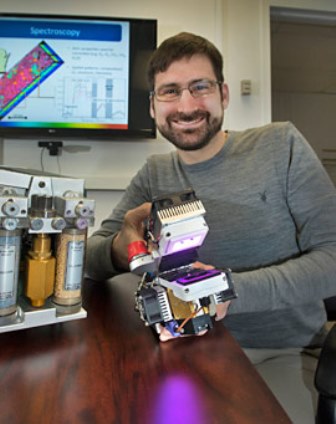
Shawn Serbin is an affiliate faculty member and assistant ecologist at Brookhaven National Laboratory (https://www.bnl.gov/envsci/testgroup/). He earned a dual masters degree in Forest Ecology and Environmental Monitoring (remote sensing degree) as well as a PhD in Forestry at the University of Wisconsin - Madison. Shawn was also a postdoctoral research at the University of Illinois at Urbana-Champaign followed by the University of Wisconsin - Madison.
Dr. Serbin is broadly trained in forest ecology, plant physiology, ecosystem science, GIS and remote sensing. His research focuses on the exchanges of carbon, water and energy between terrestrial ecosystems and the atmosphere with a focus on scaling and model-data synthesis. Shawn's research spans several global biomes and leverages a number of tools including remote sensing, spectroscopy, and novel quantitative methods, which he uses to effectively scale process knowledge.
Selected Publications
Serbin, S.P., Singh, A., McNeil, B.E., Townsend, P.A., (2014). Spectroscopic determination of leaf morphological, nutritional, and biochemical traits for northern temperate and boreal tree species. Ecological Applications, DOI: http://dx.doi.org/10.1890/13-2110.1.
Dietze, M.C., Serbin, S.P., LeBauer, D.S., Davidson, C.D., Desai, A.R., Feng, X., Kelly, R., Kooper, R., D.S., Mantooth, J., McHenry, K. (2014). A quantitative assessment of a terrestrial biosphere model's data needs across North American biomes. Journal of Geophysical Research – Biogeosciences, DOI: 10.1002/2013JG002392.
Ainsworth, E.A., Serbin, S.P., Skoneczka, J.A., Townsend, P.A. (2014). Using leaf optical properties to detect ozone effects on foliar biochemistry. Photosynthesis Research, 119(1-2), 65-76.
Bernacchi, C.J., Bagley, J.E., Serbin, S.P., Ruiz-Vera, U.M., Rosenthal, D.M., Van Loocke, A. (2013). Modeling C3 photosynthesis from the chloroplast to the ecosystem. Plant Cell & Environment, 36(9), 1641-1657. DOI: 10.1111/pce.12118.
Serbin, S.P., Ahl, D.E., Gower, S.T. (2013). Spatial and temporal validation of the MODIS LAI and FPAR products across a boreal forest wildfire chronosequence. Remote Sensing of Environment, 133, 71-84.
Isaacson, B., S. Serbin, and P. Townsend (2012). Detection of relative differences in phenology of forest species using Landsat and MODIS. Landscape Ecology, 27 (4), 529-543.
Serbin, S.P., Dillaway, D., Kruger, E.L., Townsend, P.A. (2012). Leaf optical properties reflect variation in photosynthetic metabolism and its sensitivity to temperature. Journal of Experimental Botany, 63, 489-502.
Serbin, S.P., Gower, S.T., Ahl, D.E. (2009). Canopy dynamics and phenology of a boreal black spruce wildfire chronosequence. Agricultural and Forest Meteorology, 149, 187-204.
Kucharik, C.J., Serbin, S.P. (2008). Impacts of recent climate change on Wisconsin corn and soybean yield trends. Environmental Research Letters, 3 (3), 10pp.
Elizabeth C. Stone, Professor

Elizabeth Stone is a Professor in the Department of Anthropology, she received her Ph.D. from the University of Chicago. Dr. Stone's research has been directed towards the ways in which urban structures reflect the underlying social, political and economic organization of their civilizations. This interest has been pursued on both the theoretical level and through field research. To develop a theoretical understanding of the relationship between urban form and society, she has been examining the organization of a number of well documented urban societies. These data suggest that city states differ radically from territorial states in both interpersonal relations and the nature and organization of their cities.
